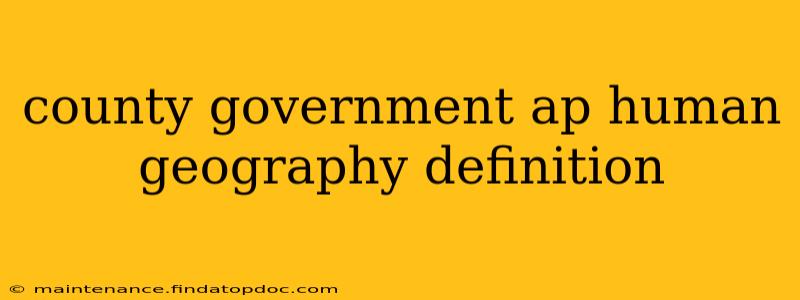County governments represent a crucial layer in the complex tapestry of political geography. Understanding their function, structure, and variations across different regions is essential for success in AP Human Geography. This post delves into the definition, roles, and variations of county governments, addressing common questions students often have.
What is County Government in AP Human Geography?
In the context of AP Human Geography, county government refers to the administrative division of a state or province responsible for governing a specific geographic area, typically smaller than a state but larger than a city. These governments provide essential services to residents within their jurisdiction, acting as a bridge between local needs and state-level policies. The exact powers and responsibilities vary significantly based on the country and even within different states or provinces of the same country. Think of them as the intermediary layer managing diverse local concerns within a broader state framework. Their structure can be diverse, ranging from directly elected officials to appointed bodies.
What are the Functions of County Governments?
County governments perform a wide array of functions, often overlapping with other levels of government:
- Law Enforcement: Many counties maintain sheriff's departments responsible for law enforcement outside of incorporated cities.
- Infrastructure: County governments frequently oversee the maintenance and construction of roads, bridges, and other public works projects within their boundaries.
- Public Health: Public health services, such as sanitation and disease control, often fall under county jurisdiction.
- Social Services: Some counties administer social welfare programs, assisting residents with issues like poverty, homelessness, or healthcare access.
- Education: Although schools are often managed at a local level, county governments may play a role in overseeing educational funding or policy.
- Courts: County courts handle many legal matters, including minor criminal cases and civil disputes.
- Record Keeping: Counties maintain vital records, including birth certificates, death certificates, and property deeds.
How do County Governments Differ Across Regions?
The structure and powers of county governments vary significantly across different regions of the world and even within a single country:
- United States: County governments in the US are highly decentralized, with significant variation in their powers and responsibilities from state to state. Some counties wield considerable power, while others function primarily as administrative arms of the state.
- Canada: Canada's equivalent of counties varies by province. Some provinces use regional municipalities or county-like structures, while others may use different models of local government entirely.
- United Kingdom: The UK uses a different system altogether, with local authorities (councils) having varying powers and responsibilities depending on their geographic area.
These differences highlight the influence of historical context, political systems, and population density on the design and functions of county governments.
What are the Strengths and Weaknesses of County Governments?
Strengths:
- Localized Services: They provide essential services tailored to the specific needs of their localities.
- Community Engagement: County governments often foster greater community involvement in governance compared to larger state or federal entities.
- Flexibility: Their decentralized nature allows for flexibility in adapting to local circumstances and changing needs.
Weaknesses:
- Inequality: The variations in resources and powers across different counties can lead to inequalities in service provision.
- Fragmentation: The decentralized nature can create fragmentation and inefficiencies in delivering services.
- Limited Resources: Many counties struggle with limited financial resources, hindering their ability to provide adequate services.
What is the Relationship Between County Government and State Government?
County governments function within the framework established by state governments. State governments often set minimum standards for services provided by counties and may exert oversight to ensure compliance. While counties have significant autonomy in many areas, ultimately they are subordinate to the authority of the state.
How do County Governments Interact with Municipal Governments?
The relationship between county and municipal governments can be complex, often involving shared responsibilities and potential conflicts. Issues such as zoning, law enforcement, and infrastructure maintenance can lead to overlap or disagreements between these levels of government. The precise nature of their interactions depends on the legal framework and the specific powers granted to each level of government.
Understanding county governments is key to comprehending the intricate workings of political geography and the diverse ways societies organize themselves to manage local affairs. This overview provides a solid foundation for further exploration within the context of AP Human Geography.
